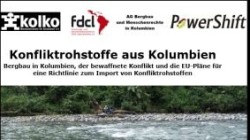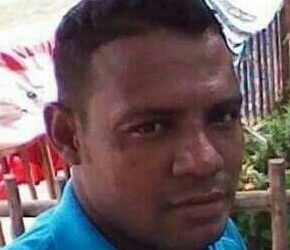Executive summary
Fuelling Conflict in Colombia: The impact of gold mining in Chocó
It is no coincidence that Chocó, a region rich in natural resources, has also been one of the focal points of the Colombian conflict, with thousands of people killed or forcibly displaced. Uncontrolled small-scale mechanised mining in Chocó has proved to be a lucrative business for illegal armed groups, helping to fuel the conflict and exploit it. These groups operate in territories belonging to indigenous and Afro-descendant communities, spreading violence and fear,with opponents of the mining threatened, attacked and killed. As well as generating violence, these mining operations haveserious health and environmental impacts, threatening thelives and livelihoods of the population and damaging largeareas of one of the world’s most biodiverse regions. (1) These communities now face a new challenge as they discover that much of their territory has been granted in concessions to multinational companies (MNCs). Investment by MNCs in Chocó is a policy actively promoted by the Colombian Government,one which is already associated with militarisation and social conflict. The majority of concessions granted to MNCs are in the early exploratory stage but they are already generating legal challenges and social protest. With 96 per cent of land in Chocó being collectively owned by indigenous or Afro- descendants, it is vital that there are genuine processes of Free, Prior and Informed Consent (FPIC) before MNCs invest further in mining operations in the region. While international norms and Colombian Constitutional Court judgments have strengthened the guarantees for Indigenous and Afro- descendant Peoples to FPIC processes, recent Colombian Government legislation appears to seek to circumvent these rights.Chocó is situated between the Darién Gap on the border withPanama and the departments of Antioquia and Valle de Cauca. It is one of the planet’s hidden tropical treasures, classified as a Forest Reserve (2) and home to approximately 56 per cent of Colombian bird species and 11 per cent of all known bird species in the world.(3)Unlike any other Colombian Department, 95 per cent of thepopulation is indigenous and Afro-descendant, living on collectively owned land. For these ethnic groups, their territory embodies the essence of life and development. Therefore territory in Colombian law for these groups is considered afundamental right. Their livelihoods revolve around hunting,fishing, farming and small-scale artisanal mining. This way of life has preserved the rich biodiversity of this exceptional corner of Colombia and, in turn, had met the communities’ basic needs for centuries. All this changed by late 1990. Chocó is a remote area of Colombia and, as such, had experienced limited conflict until 1997 when Operation Genesis, a military-paramilitary offensive, began in the north of thedepartment causing terror and mass forced displacement. In that year alone, 27,433 people in Chocó were forcibly displaced as the paramilitaries moved southwards en masse. (4) The river communities from Riosucio to Quibdó felt the force of their violence, with the Observatory for the Presidential Programme on Human Rights and International Humanitarian Law registering an intensity in the conflict ‘rarely seen’. (5) This violence coincided with the application for collective ownership of land by Afro-descendant communities in Chocó, a right incorporated into the 1991 Constitution and enacted through Law 70 of 1993. By the late 1990s many of the communities had established the governing structures required by Law 70 and had started submitting applications to the State for their formal land titles. At the same time the right-wing paramilitary groups Autodefensas Unidas de Colombia (AUC), formed into a national structure with one of its prime objectives in Chocó to take control of land on which Afro-descendants had the right to apply for collective title deeds under Law 70 of 1993. The leaders of Community Councils (governing body of collectively owned land) applying for collective land rights were threatened, disappeared, attacked, murdered and dismembered. These brutal targeted attacks and killings continue to this day. (6)
(1) Critical Ecosystem Partnership Fund, Ecosystem profile: Chocó-Manabí Conservation Corridor, Colombia and Ecuador, 2005.
(2) Ministerio de Ambiente, Vivienda y Desarrollo Territorial. Dirección de Licencias, Permisos y Trámites Ambientales. Oficio No 2400-E2-95921 de 02/09/2010. Suscrito por Magda
Constanza Contreras Morales – Coordinadora Grupo de Relación con Usuarios.
(3) Critical Ecosystem Partnership Fund, Ecosystem profile: Chocó-Manabí Conservation Corridor, Colombia and Ecuador, 2005.
(4 )Verdadabierta.com, El Atrato: Dos décadas de guerra, 23 November 2014. Centro de Recursos para el Análisis de Conflictos.
(5) Observatorio del Programa Presidencial de Derechos Humanos y Derecho Internacional Humanitario, cited in Verdadabierta.com, El Atrato: Dos décadas de guerra, 23 November 2014.
(6) Programa Somos Defensores, Los Nadies, August 2015.
Click here to read on:
ABC-Choco_mining_report_V7_Screen(1)
Spanish:
http://www.abcolombia.org.uk/downloads/ABColombia-Choco_mineria_SPANISH.pdf



